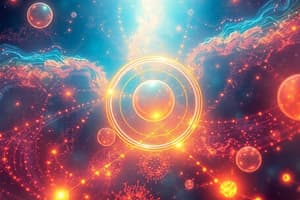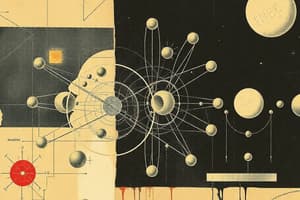Podcast
Questions and Answers
What significant event took place in 1927 involving some of the greatest scientific minds?
What significant event took place in 1927 involving some of the greatest scientific minds?
- The invention of quantum mechanics
- The first demonstration of electromagnetic waves
- The discovery of the electron
- The Solvay Conference (correct)
According to Maxwell's proposal, visible light consists of what?
According to Maxwell's proposal, visible light consists of what?
- Electromagnetic waves (correct)
- Sound waves in the air
- Static electricity
- Particles only
Which term describes the speed of light in the given equation $v = \frac{c}{\lambda}$?
Which term describes the speed of light in the given equation $v = \frac{c}{\lambda}$?
- Wavelength (correct)
- Amplitude
- Frequency
- Energy
What does electromagnetic radiation encompass?
What does electromagnetic radiation encompass?
Which of the following characteristics is NOT used to describe waves?
Which of the following characteristics is NOT used to describe waves?
What happens to the kinetic energy of electrons when the intensity of light increases?
What happens to the kinetic energy of electrons when the intensity of light increases?
What is the reason for a threshold frequency in the photoelectric effect?
What is the reason for a threshold frequency in the photoelectric effect?
Using the formula $E = \frac{hc}{\lambda}$, what is required to determine the energy of a photon?
Using the formula $E = \frac{hc}{\lambda}$, what is required to determine the energy of a photon?
If the wavelength of the microwave radiation is 1.20 cm, what unit must it be converted to for use in the energy formula?
If the wavelength of the microwave radiation is 1.20 cm, what unit must it be converted to for use in the energy formula?
How does increasing the intensity of light affect the number of photons?
How does increasing the intensity of light affect the number of photons?
What type of interference occurs when two waves are in phase?
What type of interference occurs when two waves are in phase?
What is the phenomenon called when waves bend around obstacles?
What is the phenomenon called when waves bend around obstacles?
Which of the following statements is true regarding light and diffraction?
Which of the following statements is true regarding light and diffraction?
What is the formula used to relate energy change and wavelength?
What is the formula used to relate energy change and wavelength?
What is the calculated wavelength of light in nanometers based on the provided energy change?
What is the calculated wavelength of light in nanometers based on the provided energy change?
What is a characteristic of a blackbody?
What is a characteristic of a blackbody?
How does the intensity of radiation escaping a blackbody change with temperature?
How does the intensity of radiation escaping a blackbody change with temperature?
What value is used for the Planck constant in the calculation of wavelength?
What value is used for the Planck constant in the calculation of wavelength?
What is the Ultraviolet Catastrophe?
What is the Ultraviolet Catastrophe?
How is energy change (ΔE) expressed in the calculations presented?
How is energy change (ΔE) expressed in the calculations presented?
Which statement about classical physics and blackbody radiation is correct?
Which statement about classical physics and blackbody radiation is correct?
In the context of quantum mechanics, what does the variable λ represent?
In the context of quantum mechanics, what does the variable λ represent?
What primarily contributes to the blackbody radiation observed in the visible range?
What primarily contributes to the blackbody radiation observed in the visible range?
What happens when light of frequency below the threshold frequency is used?
What happens when light of frequency below the threshold frequency is used?
What is true about light with a frequency greater than the threshold frequency?
What is true about light with a frequency greater than the threshold frequency?
How does increasing the amplitude of light affect the photoelectric effect?
How does increasing the amplitude of light affect the photoelectric effect?
What conclusion about kinetic energy can be made regarding brighter light?
What conclusion about kinetic energy can be made regarding brighter light?
What key concept did Einstein incorporate to explain the photoelectric effect?
What key concept did Einstein incorporate to explain the photoelectric effect?
What is the relationship between the energy of a photon and its frequency?
What is the relationship between the energy of a photon and its frequency?
What type of analysis was used to identify the pigment used on mummy wrappings?
What type of analysis was used to identify the pigment used on mummy wrappings?
What was the significance of Planck's ideas in relation to the photoelectric effect?
What was the significance of Planck's ideas in relation to the photoelectric effect?
What does the threshold frequency signify in the photoelectric effect?
What does the threshold frequency signify in the photoelectric effect?
Which pigment was shown to be used on the mummy wrapping after XPS analysis?
Which pigment was shown to be used on the mummy wrapping after XPS analysis?
Flashcards
Quantum Mechanical Model
Quantum Mechanical Model
A model of the atom that incorporates 20th-century scientific ideas to replace earlier models.
Solvay Conference (1927)
Solvay Conference (1927)
A meeting of prominent scientists discussing key quantum mechanics concepts.
Electromagnetic Waves
Electromagnetic Waves
Energy emitted and transmitted in oscillating electric and magnetic fields.
Light's Speed (c)
Light's Speed (c)
Signup and view all the flashcards
Wave Interference
Wave Interference
Signup and view all the flashcards
Diffraction
Diffraction
Signup and view all the flashcards
Double-slit Experiment
Double-slit Experiment
Signup and view all the flashcards
Blackbody Radiation
Blackbody Radiation
Signup and view all the flashcards
Ultraviolet Catastrophe
Ultraviolet Catastrophe
Signup and view all the flashcards
Photoelectric Effect
Photoelectric Effect
Signup and view all the flashcards
Photon
Photon
Signup and view all the flashcards
Photon Energy (E)
Photon Energy (E)
Signup and view all the flashcards
Threshold Frequency (ν₀)
Threshold Frequency (ν₀)
Signup and view all the flashcards
Amplitude
Amplitude
Signup and view all the flashcards
Maxwell's Electromagnetic Theory
Maxwell's Electromagnetic Theory
Signup and view all the flashcards
Wavelength (λ)
Wavelength (λ)
Signup and view all the flashcards
Frequency (ν)
Frequency (ν)
Signup and view all the flashcards
Learning Goals for Quantum Mechanics
Learning Goals for Quantum Mechanics
Signup and view all the flashcards
Study Notes
Quantum Mechanical Model Overview
- The Quantum Mechanical Model of the Atom replaces earlier models, incorporating new scientific ideas from the 20th century.
The Solvay Conference, 1927
- Major scientific figures gathered to discuss groundbreaking concepts in quantum mechanics.
Nature of Light
- In 1873, Maxwell proposed that visible light consists of electromagnetic waves composed of oscillating electric and magnetic fields.
- Light behavior can be described using amplitude, wavelength (λ), and frequency (ν) with the equation:
( \nu = \frac{c}{\lambda} ) where ( c = 3 \times 10^8 m/s ) (speed of light).
Electromagnetic Radiation
- Defined as energy emitted and transmitted in electromagnetic waves.
- Consists of a spectrum that includes various types of radiation.
Wave Interference
- Constructive interference occurs when waves are in phase, enhancing amplitude.
- Destructive interference occurs when waves are out of phase, reducing amplitude.
Diffraction of Waves
- Diffraction refers to the bending of waves around obstacles or openings, evidence of wave properties.
- Light shows diffraction patterns when passing through narrow openings.
Evidence Supporting Wave Theory
- The double-slit experiment demonstrates the wave nature of light through interference patterns of light and dark spots.
Blackbody Radiation
- A blackbody absorbs all radiation and re-emits it across a broad range of frequencies, with intensity varying by frequency.
- As temperature increases, the emitted frequency shifts towards the visible spectrum.
Ultraviolet Catastrophe
- Classical physics fails to predict blackbody radiation at short wavelengths, leading to the UV catastrophe.
- Proposed solutions required quantum mechanics to explain deviations.
Photoelectric Effect
- Observes that light below a threshold frequency ( \nu_0 ) does not eject electrons.
- Higher frequency light results in higher kinetic energy of ejected electrons, but doesn’t affect the ejection rate.
Amplitude and Electron Ejection
- Higher amplitude light results in more electrons being ejected per unit time but does not impact their kinetic energy.
Quantum Mechanics and Photons
- Einstein proposed that light exists as discrete packets called photons, winning the Nobel Prize for explaining the photoelectric effect.
- The energy of a photon is given by ( E_{photon} = h\nu = \frac{hc}{\lambda} ).
Threshold Frequency Explained
- A photon must have minimum energy to eject an electron, explaining the threshold frequency; photons below this value cannot eject electrons.
Example Calculation of Photon Energy
- For microwave radiation with a wavelength of 1.20 cm, the energy of one photon can be calculated using:
( E = \frac{hc}{\lambda} ), substituting known values leads to the energy outcome.
Learning Goals for Quantum Mechanics
- Recognize the need for quantum mechanics and key figures involved in its development.
- Relate energy of light quanta to their frequency and wavelength.
- Interpret atomic emission spectra through Bohr's atomic theory and calculate energy changes for emissions.
Studying That Suits You
Use AI to generate personalized quizzes and flashcards to suit your learning preferences.




